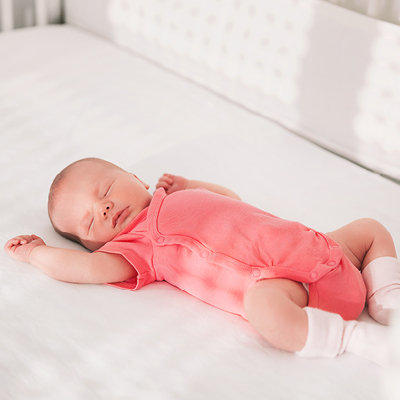Vitality eNews Sign Up
Receive the Summa Health eNewsletter for the latest health tips, advice and updates.
Safe sleep for babies: It's as easy as ABCDE
Posted November 01, 2021 by Karen Frantz DeSeptis, BSN, RNC

It’s true babies sleep a lot. In fact, they can spend up to 16 hours a day asleep in the first few weeks of life. That’s why it’s so important to make sure for every snooze — nighttime and naptime — your baby sleeps safely.
Sadly, every week in Ohio, it’s estimated 3 babies die while sleeping due to unsafe sleep practices, according to the Ohio Chapter of the American Academy of Pediatrics. In fact, Ohio has the eighth-highest infant death rate in the country, and sleep-related deaths are the most common cause of most sudden unexpected infant deaths (SUIDs).
The good news is many of these deaths are preventable. Summa Health wants to remind parents, grandparents and other caregivers the ABCDEs of safe sleep: Babies sleep safest Alone, on their Backs, and in an empty Crib for every sleep (naptime and nighttime). Additionally, individuals should practice Don’t Smoke around the baby and ensure everyone is Educated about safe sleep practices.
A is for Alone
A baby should have its own sleep space, separate from parents and other caregivers, such as a crib, bassinet or portable play yard that meets current safety standards.
- You can share the room with your baby; just don’t share the same bed. This includes napping with your baby on couches or chairs.
- The crib is the safest place for baby. Couches, rocking chairs and baby carriers are dangerous because babies can fall or suffocate.
- Do not use wedges, baby positioners or co-sleeping products that claim to reduce the risk of Sudden Infant Death Syndrome (SIDS). They are not approved safe-sleeping practices.
B is for Back
Evidence has proven babies who sleep on their backs, as opposed to their stomachs or sides, carry the lowest risk for SIDS.
- Up to 1 year of age, babies should always be placed on their backs to sleep both during naps and at nighttime.
- When babies are on their backs, they will not choke if they spit up. Studies have shown it’s harder for the spit-up to go into their windpipes while on their back.
- Once your baby can roll from their tummy to their back and back again, you don’t need to reposition your baby.
C is for empty Crib
It is unsafe to place loose objects, such as blankets, toys, stuffed animals, pillows, bumper pads or anything else in the crib with your baby. These items pose an increased risk of suffocation, strangulation and even SIDS.
- Always put your baby to sleep in an empty crib, portable crib or bassinet that meets current safety standards.
- The bed should have a firm mattress with a tight-fitted sheet. Soft mattresses and coverings increase the risk of suffocation because they could block your baby’s airway if they nestle their face into them.
- To keep your baby warm at night, use a sleeper or sleep sack instead of a blanket. Make sure the material is appropriate for the season to keep your baby from overheating or being too cold.
- If you give your baby a pacifier at naptime and bedtime, don’t attach it to a string or stuffed animal because these items increase the risk of strangulation and suffocation. Studies have shown pacifiers can help reduce a baby’s risk for SIDS.
D is for Don’t Smoke
Smoking around the baby or near their environment presents secondhand and thirdhand smoke concerns since the baby can breathe in harmful carcinogens from smoke and vapor. Individuals who smoke while pregnant also increase the chances of SIDS for the baby.
- Parents and caregivers are highly encouraged to refrain from smoking around the baby, or in areas that the baby will be in regularly.
- If someone is unable to quit, the person should smoke outside the home. Before handling the baby, smokers should wash their hands, brush their teeth and change their clothes to reduce the risk to the child.
E is for Educating Everyone
SUID or SIDS can occur outside the care of immediate family. Anyone who is watching a baby, including daycares and babysitters, should be informed about the ABCDEs of safe sleep.
- Talk about safe sleep practices with all care providers, family members and friends.
- If your child goes to daycare, make sure the facility and staff practice safe sleep with babies in their care.
Sleep guidelines have changed significantly in recent decades. For new parents, grandparents and other caregivers, it’s important to educate yourself on the American Academy of Pediatrics safe sleep recommendations to reduce your baby’s risk for SIDS and ensure safe sleep every time.
